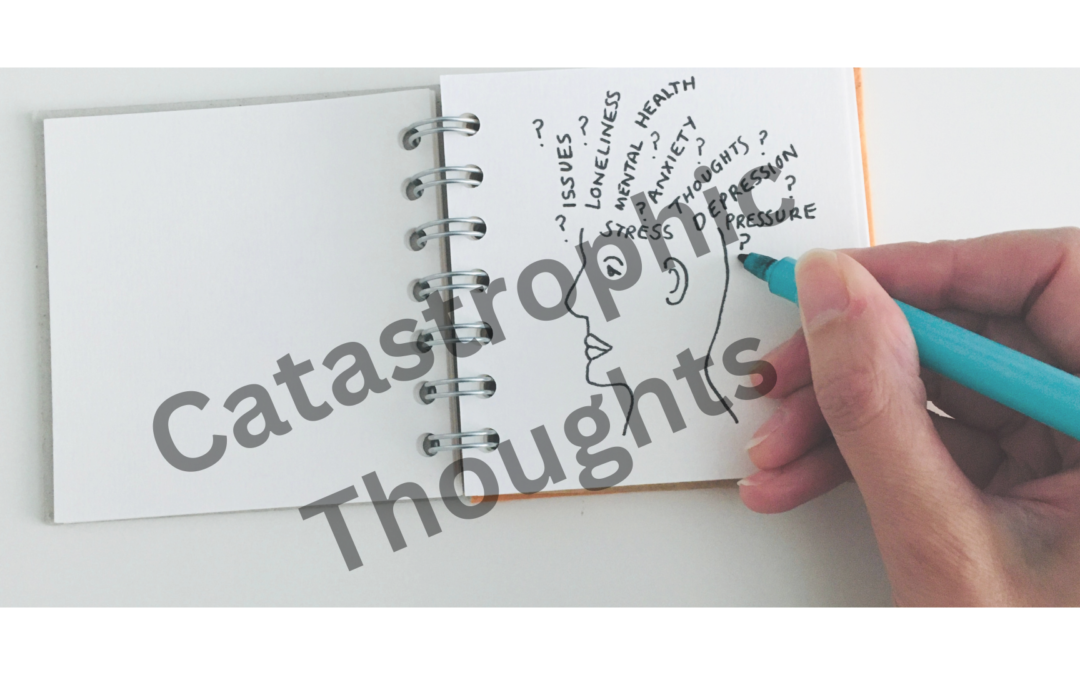Do you struggle from catastrophic thinking? Over estimating the probability of bad outcomes in what if scenarios that leave you anxious, overwhelmed and even hopeless? Read and react to this post, where I will share with you briefly, the sources of catastrophic thoughts, the effects they can have on mental health, and strategies to manage them.
Sources of Catastrophic Thoughts
There are various sources of catastrophic thoughts, but some common ones include:
- Past Trauma: People who have experienced trauma or have been through a stressful event are more likely to have catastrophic thoughts. This is because traumatic experiences can cause a person to feel like they have no control over their lives. They also expect bad things to happen because it happened to them in the past.
- Anxiety Disorders: Individuals with anxiety disorders are more prone to catastrophic thinking. Anxiety disorders can cause a person to have irrational fears, and they may imagine worst-case scenarios to prepare for them.
- Pessimistic Thinking: People who tend to see the negative side of things are more likely to have catastrophic thoughts. Pessimistic thinking can lead to a distorted view of reality, where everything seems bleak and hopeless.
- Perfectionism: Individuals with high levels of perfectionism may have catastrophic thoughts because they fear failure. They may imagine worst-case scenarios as a way of preparing for failure.
Effects of Catastrophic Thoughts on Mental Health
Catastrophic thoughts can have a significant impact on mental health. Here are some effects that it can have:
- Anxiety: Catastrophic thoughts can trigger anxiety, which can lead to physical symptoms like rapid heartbeat, sweating, and trembling.
- Depression: Constantly imagining worst-case scenarios can make a person feel hopeless, leading to depression.
- Avoidance Behaviors: People with catastrophic thoughts may avoid situations that they fear will result in negative outcomes. This can lead to isolation and further negative thinking.
- Decreased Self-Esteem: When a person only focuses on the negative aspects of a situation, they may feel helpless and powerless. This can lead to decreased self-esteem and confidence.
Strategies that can help: Let me provide more details for the first two strategies mentioned in the previous blog post: Cognitive Restructuring and Mindfulness.
Cognitive Restructuring:
Cognitive restructuring is a process that involves identifying and changing negative thought patterns. This technique is used in cognitive-behavioral therapy (CBT), a widely used form of psychotherapy that focuses on changing negative thoughts, feelings, and behaviors. Here are the steps involved in cognitive restructuring:
a. Identify Negative Thoughts: The first step in cognitive restructuring is to identify the negative thoughts that are contributing to catastrophic thinking. This can be done by writing down the thoughts that come to mind when you are feeling anxious or overwhelmed.
b. Challenge Negative Thoughts: Once you have identified the negative thoughts, the next step is to challenge them. This can be done by asking yourself questions like “Is this thought based on facts or assumptions?” “Is there any evidence to support this thought?” “What is the worst-case scenario, and how likely is it to happen?” Challenging negative thoughts can help to replace them with more realistic and positive thoughts.
c. Replace Negative Thoughts: After challenging negative thoughts, the next step is to replace them with more positive and realistic thoughts. For example, instead of thinking “I will fail this exam,” you can replace it with “I have studied hard, and I am well-prepared for this exam.”
d. Practice: Cognitive restructuring is a skill that requires practice. It can be helpful to practice challenging negative thoughts and replacing them with positive ones regularly. With time and practice, cognitive restructuring can become a natural part of your thinking process.
Mindfulness:
Mindfulness involves focusing on the present moment and accepting thoughts and feelings without judgment. Practicing mindfulness can help to reduce anxiety and catastrophic thinking by promoting a sense of calm and relaxation. Here are some ways to practice mindfulness:
a. Breathing Exercises: Breathing exercises can be a helpful way to practice mindfulness. Find a quiet place to sit or lie down and focus on your breath. Take slow, deep breaths and pay attention to the sensation of air moving in and out of your body.
b. Body Scan: A body scan is a mindfulness exercise that involves focusing on different parts of your body, starting from your toes and moving up to your head. Focus on each part of your body and notice any sensations or feelings you may have.
c. Mindful Meditation: Mindful meditation involves sitting quietly and focusing on the present moment. You can focus on your breath, a sound, or a sensation. Whenever your mind starts to wander, gently bring your attention back to the present moment.
d. Mindful Walking: Mindful walking involves walking slowly and focusing on each step. Pay attention to the sensation of your feet touching the ground and the movement of your body.
e. Practice Gratitude: Practicing gratitude can be a helpful way to practice mindfulness. Take a few moments each day to reflect on things that you are grateful for, no matter how small they may seem.
Remember if you are struggling you are not alone. Reach out for help.


